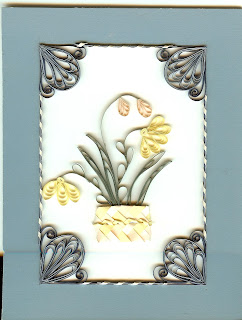Now that I have a little free time, I have been spending it
with my two dogs, my new puppy (there is no better cure for depression than a
little puppy), and a two year old Shih Tzu I am fostering trying to get him
ready for a “forever” home. I am writing about this experience in Furry Fosters.
If you are a dog lover, you might enjoy taking a peek at little Shylo’s
progress.
Last week we brought in Alli Bartkowski’s DVD Quilling Made Easy(QC550) so I sat down and watched it. I have always said anytime quillers get
together they will learn something new. Alli demonstrated a technique called
the “beehive”. I had never tried it but thought it looked like it would be a
good way of filling in areas and keeping it open and lacy looking. So I tried
it and here are the results. I did the
Christmas tree using crimped paper just to see what it would look like. The Poinsettia
I made with uncrimped papers. I created the petals using ring coils (wrapping
the paper around a ¾" dowel four times) and then used the beehive technique to
fill the petals in. I really like the look. The leaves are limple alternate side looping, and the center is a 6" strip of 1/4" paper fringed. I am fringing using a fringing die (QCT184) these days since my hand tires very quickly using my fringer. I did the poinsettia in one of our domed cards which means I can mail it with no special packaging at the first class rate. I really love these cards. They come with a round or oval dome.Alli mentioned in the DVD that this
technique was used in antique quilling and shows a 17th Century
reliquary and has recently been named the beehive technique. There are many
tutorials on YouTube if you are interested. Just search for “quilling beehive technique”. The
technique is also describe in Creative Paper Quilling (B70105) a new book put
out by Annie's Paper Crafts . The book has projects designed by many different
quillers.












